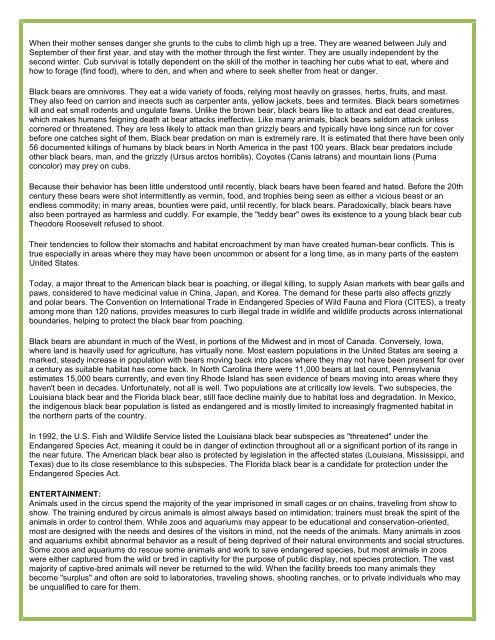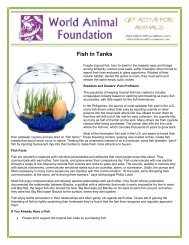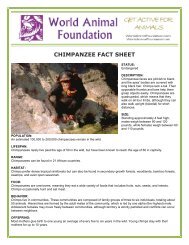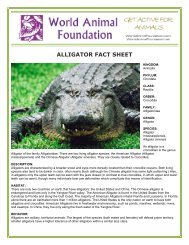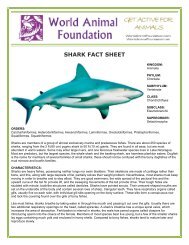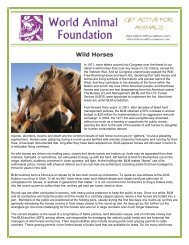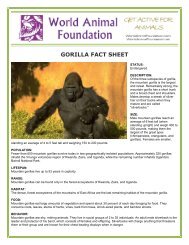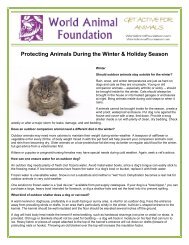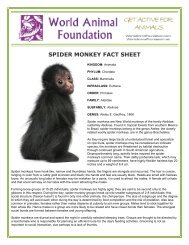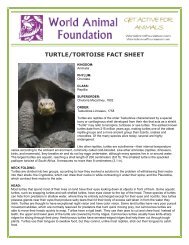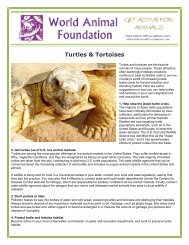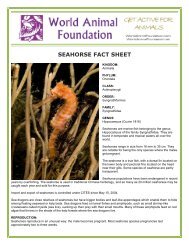BLACK BEAR FACT SHEET - World Animal Foundation
BLACK BEAR FACT SHEET - World Animal Foundation
BLACK BEAR FACT SHEET - World Animal Foundation
You also want an ePaper? Increase the reach of your titles
YUMPU automatically turns print PDFs into web optimized ePapers that Google loves.
When their mother senses danger she grunts to the cubs to climb high up a tree. They are weaned between July and<br />
September of their first year, and stay with the mother through the first winter. They are usually independent by the<br />
second winter. Cub survival is totally dependent on the skill of the mother in teaching her cubs what to eat, where and<br />
how to forage (find food), where to den, and when and where to seek shelter from heat or danger.<br />
Black bears are omnivores. They eat a wide variety of foods, relying most heavily on grasses, herbs, fruits, and mast.<br />
They also feed on carrion and insects such as carpenter ants, yellow jackets, bees and termites. Black bears sometimes<br />
kill and eat small rodents and ungulate fawns. Unlike the brown bear, black bears like to attack and eat dead creatures,<br />
which makes humans feigning death at bear attacks ineffective. Like many animals, black bears seldom attack unless<br />
cornered or threatened. They are less likely to attack man than grizzly bears and typically have long since run for cover<br />
before one catches sight of them. Black bear predation on man is extremely rare. It is estimated that there have been only<br />
56 documented killings of humans by black bears in North America in the past 100 years. Black bear predators include<br />
other black bears, man, and the grizzly (Ursus arctos horriblis). Coyotes (Canis latrans) and mountain lions (Puma<br />
concolor) may prey on cubs.<br />
Because their behavior has been little understood until recently, black bears have been feared and hated. Before the 20th<br />
century these bears were shot intermittently as vermin, food, and trophies being seen as either a vicious beast or an<br />
endless commodity; in many areas, bounties were paid, until recently, for black bears. Paradoxically, black bears have<br />
also been portrayed as harmless and cuddly. For example, the "teddy bear" owes its existence to a young black bear cub<br />
Theodore Roosevelt refused to shoot.<br />
Their tendencies to follow their stomachs and habitat encroachment by man have created human-bear conflicts. This is<br />
true especially in areas where they may have been uncommon or absent for a long time, as in many parts of the eastern<br />
United States.<br />
Today, a major threat to the American black bear is poaching, or illegal killing, to supply Asian markets with bear galls and<br />
paws, considered to have medicinal value in China, Japan, and Korea. The demand for these parts also affects grizzly<br />
and polar bears. The Convention on International Trade in Endangered Species of Wild Fauna and Flora (CITES), a treaty<br />
among more than 120 nations, provides measures to curb illegal trade in wildlife and wildlife products across international<br />
boundaries, helping to protect the black bear from poaching.<br />
Black bears are abundant in much of the West, in portions of the Midwest and in most of Canada. Conversely, Iowa,<br />
where land is heavily used for agriculture, has virtually none. Most eastern populations in the United States are seeing a<br />
marked, steady increase in population with bears moving back into places where they may not have been present for over<br />
a century as suitable habitat has come back. In North Carolina there were 11,000 bears at last count, Pennsylvania<br />
estimates 15,000 bears currently, and even tiny Rhode Island has seen evidence of bears moving into areas where they<br />
haven't been in decades. Unfortunately, not all is well. Two populations are at critically low levels. Two subspecies, the<br />
Louisiana black bear and the Florida black bear, still face decline mainly due to habitat loss and degradation. In Mexico,<br />
the indigenous black bear population is listed as endangered and is mostly limited to increasingly fragmented habitat in<br />
the northern parts of the country.<br />
In 1992, the U.S. Fish and Wildlife Service listed the Louisiana black bear subspecies as "threatened" under the<br />
Endangered Species Act, meaning it could be in danger of extinction throughout all or a significant portion of its range in<br />
the near future. The American black bear also is protected by legislation in the affected states (Louisiana, Mississippi, and<br />
Texas) due to its close resemblance to this subspecies. The Florida black bear is a candidate for protection under the<br />
Endangered Species Act.<br />
ENTERTAINMENT:<br />
<strong>Animal</strong>s used in the circus spend the majority of the year imprisoned in small cages or on chains, traveling from show to<br />
show. The training endured by circus animals is almost always based on intimidation; trainers must break the spirit of the<br />
animals in order to control them. While zoos and aquariums may appear to be educational and conservation-oriented,<br />
most are designed with the needs and desires of the visitors in mind, not the needs of the animals. Many animals in zoos<br />
and aquariums exhibit abnormal behavior as a result of being deprived of their natural environments and social structures.<br />
Some zoos and aquariums do rescue some animals and work to save endangered species, but most animals in zoos<br />
were either captured from the wild or bred in captivity for the purpose of public display, not species protection. The vast<br />
majority of captive-bred animals will never be returned to the wild. When the facility breeds too many animals they<br />
become "surplus" and often are sold to laboratories, traveling shows, shooting ranches, or to private individuals who may<br />
be unqualified to care for them.


